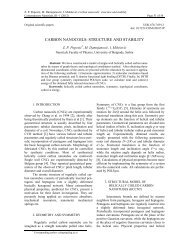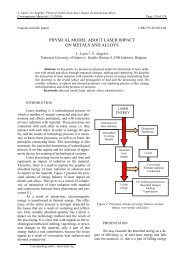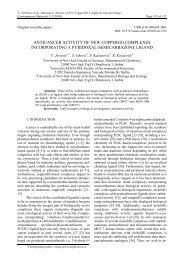physical model about laser impact on metals and alloys
physical model about laser impact on metals and alloys
physical model about laser impact on metals and alloys
Create successful ePaper yourself
Turn your PDF publications into a flip-book with our unique Google optimized e-Paper software.
L. Lazov, N. Angelov, Physical <str<strong>on</strong>g>model</str<strong>on</strong>g> <str<strong>on</strong>g>about</str<strong>on</strong>g> <str<strong>on</strong>g>laser</str<strong>on</strong>g> <str<strong>on</strong>g>impact</str<strong>on</strong>g> <strong>on</strong> <strong>metals</strong> <strong>and</strong> <strong>alloys</strong>C<strong>on</strong>temporary Materials I−2 (2010) Page 127 of 128scribe the heat propagati<strong>on</strong> in the metal caused by<str<strong>on</strong>g>laser</str<strong>on</strong>g> radiati<strong>on</strong> with classic theory of thermal c<strong>on</strong>ductivity.As it was realized, optical depth of penetrati<strong>on</strong>of <str<strong>on</strong>g>laser</str<strong>on</strong>g> radiati<strong>on</strong> in the metal is in the range of 10 -7- 10 -8 m <strong>and</strong> it is c<strong>on</strong>siderably less than the length ofheat diffusi<strong>on</strong> ( 4а). That is why in this casethe <str<strong>on</strong>g>laser</str<strong>on</strong>g> radiati<strong>on</strong> is c<strong>on</strong>sidered as surface <str<strong>on</strong>g>impact</str<strong>on</strong>g>ingheat source. Differential equati<strong>on</strong> of heat c<strong>on</strong>ductivityisTc div( k grad T ) qS (1 R), (1)twhereby T is temperature; c - specific heat capacity;ρ – density of material; k – coefficient of heat c<strong>on</strong>ductivity;q S – surface power density of <str<strong>on</strong>g>laser</str<strong>on</strong>g> radiati<strong>on</strong>;R – coefficient of reflecti<strong>on</strong>; α – coefficient ofabsorpti<strong>on</strong>.Equati<strong>on</strong> (1) describes heat transfer through h-eat c<strong>on</strong>ductivity in the most general form. One initial<strong>and</strong> two limiting c<strong>on</strong>diti<strong>on</strong>s are necessary for itsapplicati<strong>on</strong>.Initial c<strong>on</strong>diti<strong>on</strong> – temperature of samples atthe moment t = 0 is assumed to be equal to theambient temperatureT o = c<strong>on</strong>st. (2)For <str<strong>on</strong>g>laser</str<strong>on</strong>g> processing, the following applies:C<strong>on</strong>diti<strong>on</strong> of restricti<strong>on</strong> of I stockIt defines distributi<strong>on</strong> of temperature at thesample surface at every moment of the timeT o = c<strong>on</strong>st or T o = T o (t). (3)C<strong>on</strong>diti<strong>on</strong> of restricti<strong>on</strong> of II stockIt is given surface density of heat stream q S atevery point of the surface of the sample at everymoment of time. It is assumed that surface density q Sin every point of head stream across the surface q S =c<strong>on</strong>st or q S = q S (t) i.e. it is c<strong>on</strong>stant or is a functi<strong>on</strong> oftime.Since the surface density is proporti<strong>on</strong>al totemperature’s gradient we may write:T k ) q(S qxS = c<strong>on</strong>st or q S = q S (t). (4)SSoluti<strong>on</strong> of the differential equati<strong>on</strong> of heatc<strong>on</strong>ductivity at assigned initial (2) <strong>and</strong> limiting c<strong>on</strong>diti<strong>on</strong>s(3) <strong>and</strong> (4) allow us to determine the temperaturefield of the sample in the given moment of time,as it is defined as functi<strong>on</strong> T T ( x,y,z,t).For analytic soluti<strong>on</strong> of differential equati<strong>on</strong>we assume the following simplificati<strong>on</strong>s:− Heat losses as result of radiati<strong>on</strong> <strong>and</strong> c<strong>on</strong>vecti<strong>on</strong>are ignored (that is based at pulse <str<strong>on</strong>g>laser</str<strong>on</strong>g> processing);− Dependence of temperature <strong>on</strong> optical <strong>and</strong> thermo-<str<strong>on</strong>g>physical</str<strong>on</strong>g>characteristics of materials is ignored.With these limitati<strong>on</strong>s, the heat source in metalmay be c<strong>on</strong>sidered as moving surface’s heat sourcewith defined geometry of working z<strong>on</strong>e. In thiscase analytic soluti<strong>on</strong> for equati<strong>on</strong> of heat-c<strong>on</strong>ductivityis obtained.The heat c<strong>on</strong>ductivity equati<strong>on</strong> is not ananalytic soluti<strong>on</strong> of a general case <strong>and</strong> that is whynumerical methods are used for its resoluti<strong>on</strong>. Ofmany well known methods for explorati<strong>on</strong> of temperaturefields for <str<strong>on</strong>g>laser</str<strong>on</strong>g> <str<strong>on</strong>g>impact</str<strong>on</strong>g> <strong>on</strong> materials, the methodof limited elements (4) is accepted as universal<strong>and</strong> well applied.We have made certain theoretical calculati<strong>on</strong>sfor the evaluati<strong>on</strong> of described <str<strong>on</strong>g>physical</str<strong>on</strong>g> <str<strong>on</strong>g>model</str<strong>on</strong>g>,which we compared with c<strong>on</strong>crete experimental results.A c<strong>on</strong>crete technological process was examined– <str<strong>on</strong>g>laser</str<strong>on</strong>g> marking of products of carb<strong>on</strong> tool steelsУ7, У12 <strong>and</strong> alloyed tool steel Р6М5. Initial parametersfor numeric calculati<strong>on</strong>s were:- diameter of working spot d = 30 μm;- speed of marking v = 50 mm/s;- frequency of pulse repetiti<strong>on</strong> ν = 19 kHz.The trends of theoretical research are directedtowards:− Calculati<strong>on</strong> of critical pulse energy for structuralchanges E imp(sc) <strong>and</strong> critical power density q S(sc)for structural changes (sc);− Calculati<strong>on</strong> of critical pulse energy for meltingE imp(m) <strong>and</strong> critical power density at melting q S(m) ;− Calculati<strong>on</strong> of critical pulse energy for vaporizati<strong>on</strong>E imp(t) <strong>and</strong> critical power density q S(t) for vaporizati<strong>on</strong>.The results of calculati<strong>on</strong>s are presented in table1.Table 1: Calculati<strong>on</strong>s of critical pulse energy <strong>and</strong> criticalpower densityMaterialVariableУ7 У12 Р6М5E imp(sc) , mJ 10,2 11,3 13,8q s(sc) , W/m 2 2,84.10 9 3,12.10 9 3,83.10 9E imp(m) , mJ 19.9 21,9 26,8q s(m) , W/m 2 5,51.10 9 6,09.10 9 7,43.10 9E imp(t) , mJ 31,0 34,1 41,8q s(t) , W/m 2 8,60.10 9 9,49.10 9 1,16.10 10Indicative results of calculati<strong>on</strong>s very wellcorrelate with experimental data, obtained by markingof tool steels with this type of <str<strong>on</strong>g>laser</str<strong>on</strong>g> [5].







